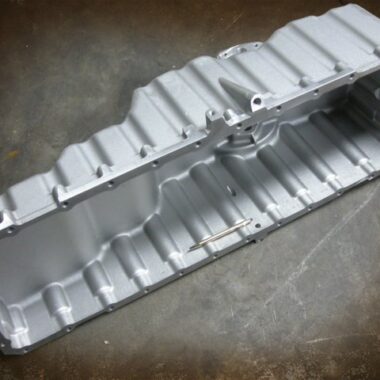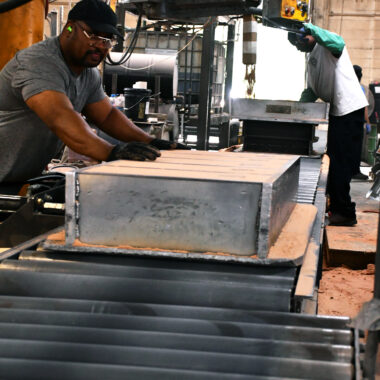Crafting Radiance: Browsing the Globe About Aluminum Casting
Crafting Radiance: Browsing the Globe About Aluminum Casting
Blog Article
Crafting Perfection: Exactly How to Achieve High-Quality Light Weight Aluminum Castings Every Single Time
In the world of aluminum spreading, the quest of perfection is a continuous trip that requires a precise strategy and a keen understanding of the intricacies involved. Achieving consistent high-grade light weight aluminum castings demands a comprehensive grasp of the procedures, from picking the appropriate alloy to implementing specific mold styles and carefully controlling casting criteria.
Recognizing Aluminum Casting Processes
Aluminum casting processes, vital in the manufacturing sector, involve the intricate improvement of liquified light weight aluminum into solid forms via a collection of very carefully regulated steps. Understanding these procedures is vital to accomplishing premium light weight aluminum spreadings consistently - about aluminum casting. The primary approaches used in light weight aluminum spreading are pass away spreading, sand spreading, and investment casting

Each of these processes has its advantages and is chosen based on elements like intricacy, volume, and wanted coating of the aluminum casting. about aluminum casting. Recognizing the intricacies of these approaches is critical for suppliers aiming to produce top quality aluminum castings regularly
Selecting the Right Light Weight Aluminum Alloy
Selecting the proper aluminum alloy is a vital choice in the manufacturing of high-quality aluminum castings. When choosing a light weight aluminum alloy for casting, it is crucial to take into consideration the certain requirements of the application to make sure optimum performance.
One of the most frequently made use of aluminum alloys for casting is A356 - about aluminum casting. For applications calling for high toughness, 7075 light weight aluminum alloy is a prominent option due to its outstanding strength-to-weight ratio.
In addition to mechanical properties, factors to consider such as expense, schedule, and post-casting processes ought to also influence the selection of the best light weight aluminum alloy. By carefully reviewing these aspects, producers can guarantee the manufacturing of premium aluminum spreadings that satisfy the preferred requirements.
Implementing Correct Mold And Mildew Design
Developing an efficient mold and mildew layout is important for making sure the effective manufacturing of high-quality aluminum spreadings. Proper mold and mildew design plays a significant duty in achieving the wanted qualities of the end product. To implement a successful mold and mildew style, aspects such as product flow, cooling down prices, and part geometry should be very carefully considered.
One secret facet of mold layout is making certain appropriate filling and solidification of the aluminum within the mold dental caries. This includes making runner and gating systems that help with smooth metal flow and avoid defects such as air entrapment or incomplete filling. Additionally, incorporating cooling networks into the mold design assists manage solidification rates and reduce the risk of porosity or shrinking problems.

Controlling Casting Parameters

Ensuring Post-Casting High Quality Checks
To maintain the excellent quality of aluminum castings, thorough post-casting quality checks are essential. After the casting procedure is completed, it is essential to ensure that the last products fulfill the wanted specs and criteria. One of the primary high quality checks entails examining the surface area coating of the castings to identify any type of flaws such as porosity, cracks, or surface irregularities. This aesthetic assessment is usually supplemented by non-destructive screening approaches like ultrasonic screening or color penetrant examination to discover inner flaws that might compromise the honesty of the Get More Info casting.
Dimensional accuracy is an additional crucial aspect that needs to be confirmed during post-casting quality checks. Dimensions of key measurements and tolerances need to be required to verify that the castings adapt the called for specs. Additionally, mechanical residential properties such as firmness, tensile stamina, and influence resistance may need to be reviewed with product testing to make certain that the castings have the required strength and resilience for their desired application.
Conclusion
Finally, achieving premium light weight aluminum castings requires a detailed understanding of the spreading processes, choosing the suitable alloy, creating molds effectively, controlling spreading parameters meticulously, and carrying out post-casting quality checks faithfully. By complying with these actions, manufacturers can constantly generate light weight aluminum castings that satisfy the highest requirements of high quality and performance.
Attaining constant high-grade light weight aluminum castings requires a comprehensive grasp of the processes, from selecting the proper alloy to executing accurate mold designs and diligently controlling casting parameters. The primary approaches utilized in aluminum casting are die casting, sand spreading, Source and financial investment spreading.
Investment spreading, also known as accuracy casting, includes producing wax patterns that are coated in ceramic to form molds.Picking the ideal light weight aluminum alloy is a critical decision in the production of top quality light weight aluminum spreadings.Making sure precise control over spreading criteria is essential for preserving uniformity and high quality in aluminum spreading production.
Report this page